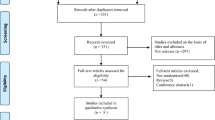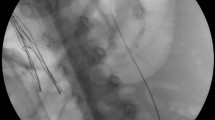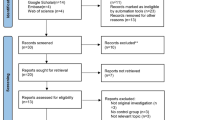Abstract
This meta-analysis aims to compare the safety and efficacy of fluoroscopy versus ultrasound guidance during the access to the renal collecting system. A systematic literature review was performed in September 2016. Outcomes were explored using review manager v5.0. 18 studies with 2919 patients were included in the final analysis. There was no significant difference in stone-free rate (RR: 1.0; 95% CI, 0.98 to 1.05; p = 0.41), operation time (MD: 1.75; 95% CI, −9.15 to 12.65; p = 0.75), hospital stay (MD: −1.02; 95% CI, −3.08 to 1.05; p = 0.34), and success rate of tract creation (RR: 1.00; 95% CI, 0.98–1.02; p = 0.88) between ultrasonography and fluoroscopy. Compared to fluoroscopy, ultrasonography had shorter puncture time (MD: −4.71; 95% CI, −6.43 to −3.0; p < 0.0001), higher success rate of fist puncture (RR: 1.16; 95% CI, 1.04 to 1.3; p = 0.01), less blood loss (MD: −0.42, 95% CI −0.81 to −0.02; p = 0.04), and less transfusion requirement (RR: 0.73; 95% CI, 0.33–1.6; p = 0.44). Two patients in each group experienced perforation of the renal pelvis. Five patients in fluoroscopy and two in ultrasonography group had pneumothorax. One patient in fluoroscopy group had intestinal injury. Both fluoroscopy and ultrasound guidance can aid to obtain successful percutaneous renal access. The advantages of ultrasonography over fluoroscopy include shorter puncture time, higher success rate of fist puncture, less blood loss, and less complications.




Similar content being viewed by others
References
Zegel HG, Pollack HM, Banner MC et al (1981) Percutaneous nephrostomy: comparison of sonographic and fluoroscopic guidance. AJR Am J Roentgenol 137(5):925–927
Basiri A, Ziaee SA, Nasseh H et al (2008) Totally ultrasonography-guided percutaneous nephrolithotomy in the flank position. J Endourol Endourol Soc 22(7):1453–1457
Evans HJ, Wollin TA (2001) The management of urinary calculi in pregnancy. Curr Opin Urol 11(4):379–384
McAleer SJ, Loughlin KR (2004) Nephrolithiasis and pregnancy. Curr Opin Urol 14(2):123–127
Francesca F, Felipetto R, Mosca F, Boggi U, Rizzo G, Puccini R (2002) Percutaneous nephrolithotomy of transplanted kidney. J Endourol Endourol Soc 16(4):225–227
Cook DA, Reed DA (2015) Appraising the quality of medical education research methods: the Medical Education Research Study Quality Instrument and the Newcastle-Ottawa Scale-Education. Acad Med J Assoc Am Med Coll 90(8):1067–1076
Clark HD, Wells GA, Huet C et al (1999) Assessing the quality of randomized trials: reliability of the Jadad scale. Control Clin Trials 20(5):448–452
Jagtap J, Mishra S, Bhattu A, Ganpule A, Sabnis R, Desai MR (2014) Which is the preferred modality of renal access for a trainee urologist: ultrasonography or fluoroscopy? Results of a prospective randomized trial. J Endourol Endourol Soc 28(12):1464–1469
Basiri A, Mirjalili MA, Kardoust Parizi M, Moosa Nejad NA (2013) Supplementary X-ray for ultrasound-guided percutaneous nephrolithotomy in supine position versus standard technique: a randomized controlled trial. Urol Int 90(4):399–404
Agarwal M, Agrawal MS, Jaiswal A, Kumar D, Yadav H, Lavania P (2011) Safety and efficacy of ultrasonography as an adjunct to fluoroscopy for renal access in percutaneous nephrolithotomy (PCNL). BJU Int 108(8):1346–1349
Karami H, Rezaei A, Mohammadhosseini M, Javanmard B, Mazloomfard M, Lotfi B (2010) Ultrasonography-guided percutaneous nephrolithotomy in the flank position versus fluoroscopy-guided percutaneous nephrolithotomy in the prone position: a comparative study. J Endourol Endourol Soc 24(8):1357–1361
Falahatkar S, Neiroomand H, Enshaei A, Kazemzadeh M, Allahkhah A, Jalili MF (2010) Totally ultrasound versus fluoroscopically guided complete supine percutaneous nephrolithotripsy: a first report. J Endourol Endourol Soc 24(9):1421–1426
Basiri A, Ziaee AM, Kianian HR, Mehrabi S, Karami H, Moghaddam SM (2008) Ultrasonographic versus fluoroscopic access for percutaneous nephrolithotomy: a randomized clinical trial. J Endourol Endourol Soc 22(2):281–284
Liu L, Liu SH, Zhang JX, Fu X, Suai Q (2013) Comparison of clinical application in percutaneous nephrolithotomy between B ultrasound and arm X light positioning. China Med Pharm 3(12):115–121
Chen MX, Wang HS, Liao XP (2012) Experience of minimally invasive percutaneous nephrolithotomy under B ultrasound combined with X-ray. Zhong guo she qu yi shi 14(24):161–163
Liang XD, Liu XL, Zhang QL (2012) B ultrasound versus fluoroscopy in percutaneous nephrolithotomy. Xinjiang Med J 42(6):55–57
Liu YL, Hu JQ, Ou ZQ, Li T (2014) B ultrasound versus fluoroscopy in percutaneous nephrolithotomy. Mod Diagn Treat 25(12):2746–2747
Xin R, Zhang GM, Xing Q (2010) Comparison of the efficacy of established access under the guidance of B-ultrasound and radiography in percutaneous nephrolithotomy. Chin J Clin Healthcare 12(1):54–56
Wu XH, Jiang XZ, Zhong KB, Dai YB (2007) Comparison of the efficacy of established percutaneous access under the guidance of B-ultrasound and radiography. J Modern Med Health 24(5):649–651
Sun XH, Lin WT, Wu WZ, Tan JM (2007) Comparison of the efficacy of B-ultrasound versus radiography in percutaneous nephrolithotomy. Chin J Misdiag 7(28):6755–6756
Dong GQ (2014) Comparison of ultrasonography versus fluoroscopy for renal access in minimally invasive percutaneous nephrolithotomy. China Foreign Med Treat 5(14):164–165
Wu JP, Liu J, Jia RP, Shu JH, Shen MS, Sun HB, Cao ZG (2013) Comparison of ultrasound and X-ray in establishing percutaneous access for minimally invasive percutaneous nephrolithotomy. J Modern Urol 18(1):46–47
Zhu ZP, Di JM (2013) Comparative analysis of percutaneous nephrolithotomy with B ultrasound and X-ray guided puncture in treatment of kidney calculi. Chin J Endourol 7(3):213–215
Yang XM, Liu G, Liu J, Chang LS, Yang YF, Song DK (2007) Comparison of ultrasound and X-ray in establishing percutaneous nephrolithotomy aisies. Chin J Pract Med 36(14):39–41
Chen HM, Li YS, Xu YG (2013) The comparative analysis of ultrasound and X-ray guided percutaneous nephrolithotomy in the treatment of renal calculus. J Laparosc Surg 18(7):497–499
de la Rosette J, Assimos D, Desai M, Gutierrez J, Lingeman J, Scarpa R et al (2011) The Clinical Research Office of the endourological society percutaneous nephrolithotomy global study: indications, complications, and outcomes in 5803 patients. J Endourol 25:11–17
Lipkin ME, Preminger GM (2012) Risk reduction strategy for radiation exposure during percutaneous nephrolithotomy. Curr Opin Urol 22(2):139–143
Kumar P (2008) Radiation safety issues in fluoroscopy during percutaneous nephrolithotomy. Urol J Winter 5(1):15–23
The 2007 Recommendations of the International Commission on Radiological Protection. ICRP publication 103. Annals of the ICRP. 2007;37(2–4):1–332
Akman T, Binbay M, Sari E et al (2011) Factors affecting bleeding during percutaneous nephrolithotomy: single surgeon experience. J Endourol Endourol Soc 25(2):327–333
Song Y, Ma Y, Song Y, Fei X (2015) Evaluating the Learning Curve for Percutaneous Nephrolithotomy under Total Ultrasound Guidance. PLoS One 10(8):e0132986
Andonian S, Scoffone CM, Louie MK et al (2013) Does imaging modality used for percutaneous renal access make a difference? A matched case analysis. J Endourol Endourol Soc 27(1):24–28
Park S, Pearle MS (2006) Imaging for percutaneous renal access and management of renal calculi. Urol Clin N Am 33(3):353–364
Acknowledgements
Supported by Grant 31170907, Grant 31370951, Grant 81470927, Grant 81300579 from the National Natural Science Foundation of China, Grant 2014SZ0028 from the Technology Support Program of Science and Technology Department of Sichuan Province, and Grant 2014SCU04B21 the scientific research foundation of Sichuan University for talented young scholars.
Conflict of interest
The authors have declared that no conflict of interest exists.
Author information
Authors and Affiliations
Corresponding author
Rights and permissions
About this article
Cite this article
Liu, Q., Zhou, L., Cai, X. et al. Fluoroscopy versus ultrasound for image guidance during percutaneous nephrolithotomy: a systematic review and meta-analysis. Urolithiasis 45, 481–487 (2017). https://doi.org/10.1007/s00240-016-0934-1
Received:
Accepted:
Published:
Issue Date:
DOI: https://doi.org/10.1007/s00240-016-0934-1




